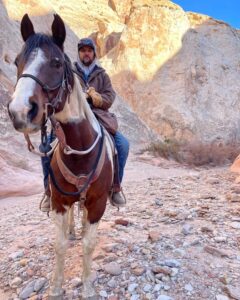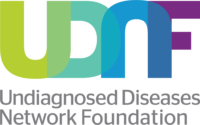24 Jan Troy Evans
 I am Troy Evans. An undiagnosed male from Utah. I consider myself a “neuromuscular disease fighter” and that word, “fight” crosses my mind many times per day. As I’ll explain later, this unknown enemy has wiped out most of my leg muscles. It’s also allowed me to explore adaptions for many of the activities I participate in. Three years ago I decided to pursue a lifelong interest of horseback riding. Although I can stand on even ground, I’m physically unable to mount a horse like most others. So after hours and hours of work, I have taught my horses to allow me to climb up something tall, a rock, a tree stump, the side of the truck, etc. And once I’m there, they come walk underneath me and stand until I’m mounted. On a recent winter day horseback riding through the deserts of Utah, I began putting my thoughts together for this piece.
I am Troy Evans. An undiagnosed male from Utah. I consider myself a “neuromuscular disease fighter” and that word, “fight” crosses my mind many times per day. As I’ll explain later, this unknown enemy has wiped out most of my leg muscles. It’s also allowed me to explore adaptions for many of the activities I participate in. Three years ago I decided to pursue a lifelong interest of horseback riding. Although I can stand on even ground, I’m physically unable to mount a horse like most others. So after hours and hours of work, I have taught my horses to allow me to climb up something tall, a rock, a tree stump, the side of the truck, etc. And once I’m there, they come walk underneath me and stand until I’m mounted. On a recent winter day horseback riding through the deserts of Utah, I began putting my thoughts together for this piece.
My undiagnosed journey is not different from many of yours. In 2018, at the age of 33, I had the fortunate opportunity to be seen by Dr. Nelson and the UDN team at the UCLA clinical site. To date, I remain undiagnosed. But I believe a diagnosis is coming.
In December 2005, at the age of 21, I first noticed something different. I had grown up athletic and hitting every major milestone. I was rarely sick and considered myself to be in very excellent physical shape. I participated in many activities – running, hiking, competitive athletics, cycling, even racing motorcycles.
Until one day, after going for a run, I noticed my calf muscles unusually sore. That soreness lasted for a few days. When it finally wore off, I went running again and, again, had the same result of soreness. 2006 brought continued soreness and the beginning stages of muscle weakness in my legs. I began falling each time I tried to sprint. I became unable to stand up out of a squatted position.
In 2007 I saw my general physician. He ran a basic blood test and called me back a few days later to refer me to a local neuromuscular specialist because of a high CK report. Little did I know at that time that I was beginning an odyssey that would change my life.
Through 2018 my odyssey outside of the UDN included:
In February 2007 I was referred to the University of Utah for clinical visits with Dr. Bromberg that continued annually through 2018. After a targeted genetic test, the first of four EMG tests, and a muscle biopsy, in the fall of 2007 Dr. Bromberg began calling my condition SMA4, or an “adult-onset spinal muscular atrophy.” This, despite normal test results for mutations in the SMN1 and SMN2 genes.
And, thus began a pattern of late night google searches.
With his blessing, I requested to see other specialists at the University of Utah and, over time met with Dr.’s Flanigan and Swaboda. Additional blood and EMG tests were performed. At the conclusion of which, they were unaware of any other possible diseases, tests, or programs that could help my case.
So…back to google I went.
In 2012 I began conversations with Dr. Baloh at Cedars Sianai in Los Angeles, CA. Accompanied by my father, I met with Dr.’s Baloh and Lewis where they performed another EMG test. Like the specialists at the University of Utah, they too were stumped as to my disease. They described a way to do advanced genetic testing that is superior to the targeted SMN genetic testing previously done. After paying a disgustingly large sum of money and waiting upwards of five months, GeneDX sent back my Whole Exome Sequencing report to Dr. Baloh. Oh my, how time has made this process much more efficient!
The GeneDX report showed some possible variances but after further research, nothing that resulted in any additional insights.
So…back to google I went.
This type of pattern went on for another few years until, in 2017, Dr. Baloh agreed to approach GeneDX to reanalyze the WXS completed in 2013. Again, the results came up empty.
Now, I don’t have a background in genetics, or biology, or medicine, and yet during this time I had this stressful feeling that I’ll need to continue researching this on my own for answers. And I had a resolve that I would contact as many specialists as it took. It was lonely. And a very unsettling time.
Overall, the tests and clinical visits brought such misdiagnoses as:
Tay Sachs
ALS
Spinal Muscular Atrophy
Limb-Girdle Muscular Dystrophy
Today, I am still able to walk, albeit with an abnormal gait that locks my knees. Without assistance I am unable to stand up from a chair, or walk up stairs, inclines, or uneven surfaces. My days of playing sports and racing motorcycles are over, for now.
You are all aware of how difficult it is to accurately portray what goes through the mind and heart of an undiagnosed patient or the loved one of someone undiagnosed. But, I will attempt to quickly provide insight into the value I’ve received from the UDN from my perspective. The unsettling and stressful feelings I previously had are gone. They are not gone because I’m cured, on a therapy plan. Or even received a diagnosis yet. NO, they are gone because for the first time in this journey, I truly believe the best team is working on my case. Instead of being limited to matching my symptoms to a well-known disease, which obviously hasn’t worked, the UDN is working beyond those limits. The calming feeling the UDN has brought to my life, to me, is the best example I can give of the value the UDN provides, not only to those whom a diagnosis has been made, but to all UDN participants.
And in the meantime, I’m doing all I can to try to live each day as full as I can. And today, that meant adaptive horseback riding.



